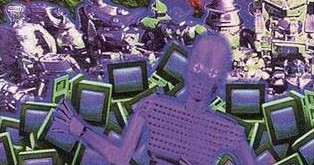
| last update 24.11.2025 11:20 | |||||
|
| What's a CCG? |
| What's Netrunner? |
| How To Start? |
| Rules Of Play |
| What's Cyberpunk? |
What is a Collectible Card Game (CCG)?Collectible card games (CCGs), also called customizable card games or trading card games, are played using specially designed sets of cards. While trading cards (sports cards, for example) have been around for much longer, CCGs combine the appeal of collecting and strategic game play. A new game genreThe first collectible card game was Magic: The Gathering, designed by Richard Garfield, published by Wizards of the Coast in 1993. Role-players were enthusiastic early fans of Magic because of its fantasy genre, but the game achieved much wider popularity among strategy gamers. Magic inspired an entirely new game genre, and has been played by an estimated fifty million players in over seventy countries worldwide since its inception. There is also a successful online version called Magic: Arena. The game is a strategy contest which includes an element of chance due to the random distribution of cards during shuffling. The game has an official tournament system, in which the game is played for cash prizes, and the game has a number of professional players. Tournaments have been played on all seven continents, including Antarctica. The commercial success of the game prompted a wave of other collectible card games to flood the market from the mid-1990s until today. Many of them were poorly designed and failed both commercially and in popularity while others were quite good and considered equal in gameplay quality, stature, and popularity to Magic the Gathering. Netrunner is one of the latter kind (in terms of gameplay quality and strategy level), also designed by Richard Garfield and published by Wizards of the Coast in 1996. GameplayEach CCG system has a fundamental set of rules that describes the players' objectives, the categories of cards used in the game, and the basic rules by which the cards interact. Each card will have additional text explaining that specific card's effect on the game. They also generally represent some specific element derived from the game's genre, setting, or source material. The cards are illustrated and named for these source elements, and the card's game function may relate to the subject. Netrunner, for example, is based heavily on the Cyberpunk 2020 role-playing game published by R. Talsorian Games, but also draws additional flavor from the broader cyberpunk genre. Almost all CCGs are designed around a single resource system by which the pace of each game is generally controlled. Frequently, the cards which comprise a player's deck are also in and of themselves a resource, with the frequency of cards moving from the deck to the play area or player's hand being tightly controlled. Relative card strength is often balanced by the number or type of basic resources needed in order to play the card, and pacing after that may be determined by the flow of cards moving in and out of play. Resources may be specific cards themselves, or represented by other means (i.e. tokens in various resource pools, symbols on cards, etc...). Players select which cards will compose their deck from the available pool of cards - unlike traditional card games such as poker or UNO where the deck's content is limited and pre-determined. This allows a CCG player to strategically customize their deck to take advantage of favorable card interactions, combinations and statistics. During a game, players traditionally take turns playing cards and performing game-related actions. The order and titles of these steps vary between different game systems, but these are typical:
Distribution and value of cardsMost collectible card games are distributed as sealed packs containing a subset of the available cards, much like trading cards. Some of the most common distribution methods are:
CCG cards are most often produced in various degrees of scarcity, generally denoted as common, uncommon, and rare. Some games use alternate or additional designations for the relative rarity levels. Special cards may also only be available through promotions, events, or redemption programs. The cards themselves have individual value, much like other trading cards, but a CCG card's value is based not only on scarcity and intangible aesthetic qualities such as the quality of the card's artwork, but is primarily a function of its game play potential, with more powerful cards carrying a correspondingly greater value. |